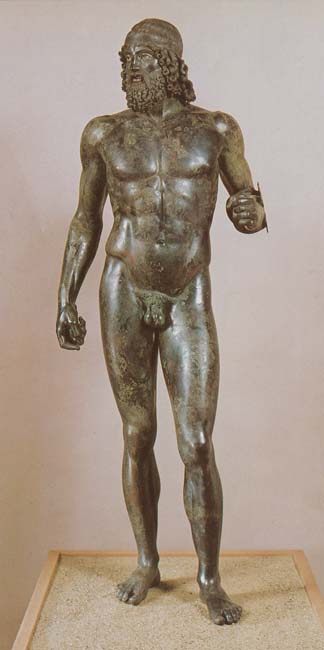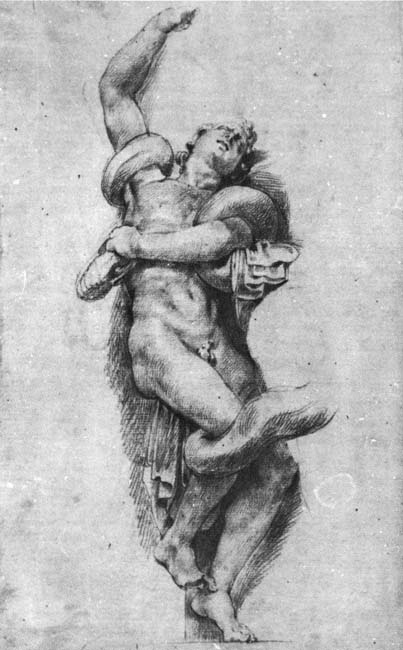Often when people discuss culture they are referring to things like the fine arts, classical music, opera and other “superior” arts. While culture encompasses all those things it includes much more. Art forms such as popular music and even comic books are part of our culture. All humans have a culture of some form. But do not ask me for a definition of what the term means as no one has been able to provide an accurate one. Since having a culture is so characteristic of humans many have tried to define it in such a way as to exclude it from animals. However they have been completely unsuccessful. Animals like the chimpanzee have a culture, albeit of a somewhat primitive nature. I may not be able to provide a definition of culture but teaching and learning are important features in the transmission of culture.

One of the Riace Bronzes (created about 460 – 420 BC)
Our culture, all others as well, is descended from the culture of previous generations. However culture is not only passed on it evolves as well. Certain cultures from the past have had great influence on us while others have been forgotten. One culture that had great importance to ours despite the great separation in time is that of the classical Greeks. Politics is part of culture and it was in ancient Greece where democracy was first born. The influence of the classical Greeks can be found in the visual arts as well despite the separation of about 2500 years. The classical Greeks developed an art based idealistic but realistic portrayal of the human figure. Their cities were filled with such art for both political and religious purposes (although at the time there was not much of a distinction between the two). The figures were idealized not only in form but in the emotion portrayed as well. The figures have a calm, almost serene, disposition and extremes in emotions or motion were generally avoided.

Pergamon Alter (2nd century BC)
About the time of Alexander the Great, classical Greek art evolved into what is usually referred to as Hellenistic art. Unusual subjects and posses became common. The human figure no longer adhered to the classical standards and became more expressive. Pathos became more often depicted in art.
While cultures often developed from particular regions, their continued existence was by no means limited to that of some ethnical group. Eventually the ancient Greeks succumbed to the military might of Imperial Rome. But this did not mean the end to the centuries long tradition of Greek art. The Roman world recognized the importance of Greece and added portions of it to its own culture. This was a backhanded compliment because many of Greek’s art treasures were looted and sent to Rome. The Riace bronze statue illustrated above were found off the coast of Italy was most likely loot from Greece aboard a ship that sank on its final voyage.
In time the mighty Roman Empire also declined and Europe entered into a period often called the Dark Ages. Much of the ancient culture was lost. Surviving bronze statues were melted down to make weapons. Ancient marbles were feed to kilns to produce lime. Painting were generally too fragile to withstand the passage of time. Much of the ancient literature was also lost however some was copied and saved especially outside of Europe by the Islamic cultures. Among the preserved literature included descriptions of ancient art. For instance this one from Pliny the Elder’s Natural History:
There are many whose fame is not preserved. In some cases the glory of the finest works is obscured by the number of artists, since no one of them can monopolize the credit, nor can the names of more than one be handed down. This is the case with the Laocoon, which stands in the palace of the Emperor Titus, a work to be preferred to all that the arts of painting and sculpture have produced. Out of one block of stone the consummate artists, Hagesandros, Polydorus and Athenodoros of Rhodes made, after careful planning, Laocoon and his sons, and the snakes marvelously entwined about them.
Ancient descriptions such as these were more a reminder of how much had been lost and not very useful in understanding what the art really looked like. The story of Laocoon and his sons the sculpture depicted was based a story from the Trojan Wars. Laocoon was a Trojan priest who tried to warn his fellow Trojans to “beware of Greeks bearing gifts”. The gods sent a serpent to kill him and his two sons. (On a side note, Pliny the Elder died while trying to investigate the eruption of Mount Vesuvius during which Pompeii and other nearby communities were entombed).

Laocoon (about 40 to 20 BC) by Hagesandros, Polydorus and Athenodoros
Time passed and Europe eventually started to recover from the Dark Ages. This period has been referred to the Renaissance, the rebirth. Progress in the arts came from new discoveries but also by rediscovering the ancient cultures of Rome and Greece. Unearthed ancient sculpture were treated as treasures and carefully studied. The Laocoon sculpture described by Pliny was rediscovered on January 14, 1506. This was a sensation with artists and scholars because the statue was immediately identified as the one written about by Pliny. One of the artists who visited the excavation on the very first day of the discovery was Michelangelo, one of the foremost artists of the Renaissance.
As originally found the sculpture was missing Laocoon’s right arm. There arose a dispute on how the sculpture should be restored. Today it would almost certainly be left as found but in those days missing parts would often be fabricated so that the sculpture would appear unblemished. Michelangelo declared that the missing arm was originally bent. However there was a bitter rivalry between Michelangelo and another sculptor by the name of Bandinelli. Now I suspect that most of my readers are familiar with the name of Michelangelo but do not feel bad if you do not recollect Bandinelli. Both may have been well known in their day but today Bandinelli is generally known only by art historians. Bandinelli declared that the Laocoon’s arm should be restored straight. Surprisingly it was Bandinelli’s interpretation that was used for the restoration. Michelangelo had spent time dissecting corpses to develop a thorough understanding of human anatomy so you would think that what he said would have carried more weight. But Michelangelo had more commissions than he could handle (actually more than he could every finish) so perhaps he simply was too buy to assist in the restoration of the Laocoon sculpture. But Michelangelo would posthumously have the last laugh. Sometime about 1963 the original arm from the Laocoon sculpture was rediscovered and just as Michelangelo had predicted it was bent. The image of the Laocoon that I provided above has the original arm reattached.

Sketch of Laocoon by Michelangelo (1530)
The Laocoon and some other rediscovered Hellenistic sculptures had an immense affect on the art of Michelangelo. The importance of the Laocoon can be seen in the Medici Chapel in Florence. I do not mean the architecture and sculptures that Michelangelo executed for the Medici Chapel although that connection seems pretty clear to me as well. To explain I first have to tell a short story. The Medici were the effective rulers of Florence. However the Medici were not loved by all and a revolt occurred which drove them out of Florence. Despite the fact that the Medici had previously been Michelangelo’s patrons the artist joined the rebellion. However in the end the revolt failed and Michelangelo was a wanted man whose life would almost certainly have been lost had he been captured. In 1530 he hid out to escape his enemies in a passage below the Medici Chapel. To pass the time Michelangelo drew on the walls of his hideout. They are wonderful sketches that relate to his work on the Medici Chapel and Sistine Chapel ceiling. There is even what appears to be a self portrait. You can read more about Michelangelo’s graffiti in a wonderful web page by the Moscow Florentine Society. The presence of the underground chamber was not well advertised when I visited Florence years ago and I had to get permission to see it. My time alone in the room was one of my most moving experience of my visit to Florence and perhaps of my life. All of Michelangelo’s sketches there appear to have based on his own art save one, a portrait of Laocoon. The Laocoon sculpture was so important to Michelangelo that twenty four years after it’s rediscovery the artist would capture it accurately during what he thought at the time could be his lasts days on earth. (Michelangelo was eventually pardoned and lived a long and productive life.)

Sketch of one of Laocoon’s Sons by Peter Paul Rubens (sometime between 1602 and 1608)
The effect of the Laocoon continued after Michelangelo as well. It was an important influenced on Baroque art and its leading artist, Peter Paul Rubens. The ancient sculpture was less important to the art periods that followed but it was never forgotten. At least by those who studied art history.

Action Comics #80 (January 1945) “The Pillage of the Parthenon”, pencils by Mort Meskin.
One of those who had not forgotten about the ancient Laocoon piece of art was Mort Meskin. Mort did a magnificent rendition of it in the splash for the Vigilante story “The Pillage of the Parthenon”. The Greek sculpture does not appear elsewhere and the story has only a tenuous connection to the Parthenon or any other aspect of ancient Greek culture. That Meskin would depict the Laocoon in a piece of comic book art expected to be read by juveniles would certainly have been for his own satisfaction. He could not expect his audience to recognize it. I suspect the only piece of ancient art that has achieved the status of an icon with the general public is the Venus de Milo.

Real Clue Crime Stories v. 2 no. 6 (August 1947) “Get Me the Golden Gun” page 15 panel 4, pencils and inks by Jack Kirby
A contrast can be made between Meskin and another great comic book artist, Jack Kirby. Kirby included sculpture in some of his comic book work. But while Kirby’s depictions of sculpture are quite interesting and well done they are completely derived from his own imagination. It is clear that unlike Meskin, Kirby had not spent much time studying art history and the ancient Greek culture.
Sources:
- Bieber, Margarete “Laocoon, The Influence of the Group Since its Rediscovery” 1967
- “Due Bronzi da Riace” 1985
- Saflund, Gosta “The Polyphemus and Scylla Groups at Sperlonga” 1972
- Schmidt, Evamaria “The Great Alter of Pergamon”, 1962

